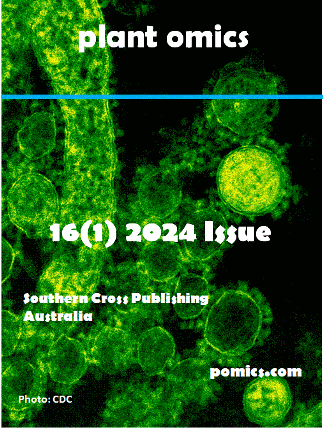ISSN: 1836-3644 (online) | ISSN: 1836-0661 (print)
plant omics
Journal
KEY FACTS
- Fully Open Access
- Rapid Peer-Review (30-40 days!)
- Rapid Publication
- Online Submission System
- Manuscript Tracking Online (24/7 hrs)
- RG Journal Impact (1.00)
- Indexed by Australian INFORMIT
- Web of Science Clarivate (BIOSIS)
- Indexed by SJR (0.22)
- H Index 2021 (27) (SJR)
- SCOPUS Cite Score 2021 (1.4)
- SNIP 2021 (0.402)
Articles 2025 | 17(03): 2025
Genome-wide identification and characterization of Inositol Phosphokinase (IPK) gene family in wheat (Triticum aestivum L.)
Saira Ibrahim, Tayyaba Andleeb, Muhammad Ramzan Khan, Muhammad Uzair
Department of Biochemistry, Faculty of Biological Sciences, Quaid-i-Azam University, Islamabad, Pakistan
Department of Plant Sciences, Faculty of Biological Sciences, Quaid-i-Azam University, Islamabad, Pakistan
National Institute for Genomics and Advanced Biotechnology (NIGAB), National Agricultural Research Centre (NARC), Islamabad, Pakistan
Abstract
Inositol phosphate kinases (IPKs) play vital roles in the synthesis and regulation of cellular levels of inositol polyphosphates, which perform vital functions in eukaryotic cells as second messengers. Due to the vital biological roles of the inositol phosphates, the kinases involved in their synthesis have gained great attention. The IPK gene family has not been extensively studied in bread wheat (Triticum aestivum). In the present study, we reported a genome-wide identification, phylogenetic analysis and expression patterns of the IPK gene family in wheat. Gene structure, genome distribution, motif conservation, and gene ontology enrichment analysis were carried out systematically. A total of 24 inositol phosphate kinase (IPK) genes were identified in the wheat genome that belonged to 8 homoeologous groups. The TaIPK genes were distributed on chromosomes 1, 2, 3, 4, 5 and 7 in all the three sub-genomes A, B, and D. Based on phylogenetic analysis, these genes were classified into four subfamilies. The subfamilies were defined based on conserved domains, motifs, chromosome locations, and gene structures. Eight pairs of paralogous IPKs were identified based on the phylogenetic relationships among wheat IPKs. Gene ontology enrichment analysis revealed the significant role of IPK genes in different biological and molecular processes in addition to their role in inositol phosphate signaling. At different developmental stages, all the 24 TaIPKs exhibited diverse expression patterns in different tissues showing diversity in their biological functions. The current study identified and explored the properties of 24 IPK genes in the wheat genome at diverse levels, thus providing a strong foundation for researchers to understand the family of these kinases in wheat.
Pages 1-11 | Full Text PDF| doi: 10.21475/POJ.17.03.25.pne02
......................................................................................................................................................................................................................
Improving biochemical and phytochemical compounds in purslane (Portulaca oleracea L.) by mannitol under salt stress conditions
Daryush Talei*, Ayatollah Rezaei, Mojtaba Khayam Nekouei, Saeid Kadkhodaei
Medicinal Plants Research Center, Shahed University, Tehran 3319118651, Iran
Department of Horticultural Sciences, Faculty of Agriculture, Shahed University, Tehran, Iran
Faculty of Biological Science, Tarbiat Modares University, Tehran, Iran
Assistant Professor, Agricultural Biotechnology Research Institute, Tehran, Iran
ORCID ID: https://orcid.org/0000-0001-8699-850X
Abstract
This study aimed to investigate the impact of mannitol on the biochemical and phytochemical responses in purslane plants subjected to salinity stress conditions. For this purpose, a factorial experiment was carried out using a completely randomized design (CRD) with two factors and four replicates. The factors were four concentrations of mannitol (0, 10, 20, and 30 mM) and two salinity levels (control and 120 mM of NaCl). During the vegetative stage, the biochemical components, soluble sugar, relative water contents, and phytochemical compounds were measured. The results indicated a significant difference between salinity and mannitol levels regarding the most studied traits. The results demonstrate that the interaction effects of salinity and mannitol levels affected total leaf soluble proteins, proline, soluble carbohydrate amount, relative water content (RWC), and phytochemical compounds. According to our findings, the foliar application of mannitol significantly increased the amount of soluble carbohydrates (glucose, xylose, and mannose), leaf protein content, and phytochemical compounds under salinity conditions. Additionally, the proline and RWC showed a positive response to the application of mannitol. In conclusion, the foliar application of mannitol under salinity stress may counteract the negative effects of such stress and improve Portulaca oleracea tolerance to salinity by increasing some biochemical and plant secondary metabolites.
Pages 12-19 | Full Text PDF| doi: 10.21475/POJ.17.03.25.pne24
...........................................................................................................................................................................................................................
Identification of some volatile antifungal compounds from Thevetia peruviana seed extracts and their efficacy in controlling late blight on potatoes
Sylvère Landry Lontsi Dida*, Hubert Bolie, Patrice Zemko Ngatsi, Paul Martial Tayo Tene, Fabrice Christian Gbaporo, Thierry Songwe Atindo, Zachée Ambang
Laboratory of Biotechnology and Environment, Phytopathology and Plant Protection Research Unit, Department of Plant Biology, University of Yaounde I, P.O. Box 812, Yaounde-Cameroon
Department of Agriculture, Higher Technical Training College of Ebolowa, University of Ebolowa, P.O. Box 886 Ebolowa-Cameroon
Laboratory of Phytoprotection and Genetic Resources Valorization, Biotechnology Center of Faculty of Science, University of Yaounde I, Yaounde, Cameroon
ORCID ID: 0000-0003-0350-5365
Abstract
To enhance potato production through sustainable management of potato late blight caused by Phytophthora infestans, this study aims to control the development of late blight on potatoes field using Thevetia peruviana seeds extracts of analyzed by Gas Chromatography-Mass Spectrometry (GC-MS). The experimental design was a split-plot with main plots potato varieties (Manate and Cipira) and in sub-plots treatments (aqueous extract; synthetic fungicide Bravo 720 combined with an insecticide Decis 5CE; synthetic fungicide Bravo 720; methanol extract and control) was used during two cropping seasons (rainy season (RS) and dry season (DS)). Disease evolution and tuber yield were evaluated. As results, the most prevailing biochemical active compounds identified by GC-MS analysis were beta-Sitosterol (86.22%) and n-Hexadecanoic acid (19.08%) in aqueous and methanol extract, respectively. The treatments reduced late blight severity of 90% during the DS and 75% during the RS. Globally, commercial yields ranged from 0 to 13.93 t. ha-1 during the RS compared with 4.98 to 16.97 t/ha during the DS. Control recorded the lowest commercial yields (0 t. ha-1 during RS and 4.98; 5.50 t. ha-1 during DS, respectively for local and improved varieties. Principal Component Analysis reveals that for both seasons, aqueous and methanol extract, synthetic fungicide and combination of fungicide and insecticide were closer to yields compared to the control treatments, which were very close to disease incidence and severity. The local variety Manate was more susceptible to late blight than the improved variety Cipira. Thevetia peruviana extract can be considered a good source of natural antimicrobials for disease management strategies.
Pages 30-32 | Full Text PDF| doi: 10.21475/POJ.17.03.25.pne30
...............................................................................................................................................................................................................................
Isolation and expression analysis of ascorbate peroxidase gene from lentil
Heba Rasmi Ramadan, Saeid Abu-Romman*, Nidal Odat
Department of Biotechnology, Faculty of Agricultural Technology, Al-Balqa Applied University, Al-Salt 19117. Jordan
Department of Medical Laboratories, Faculty of Science, Al-Balqa Applied University, Al-Salt 19117. Jordan
Abstract
Ascorbate peroxidase (APX) is an important enzyme that plays a pivotal role in the detoxification of cellular H2O2 and as a central component of AsA-GSH cycle. This enzyme belongs to the class I superfamily of heme-containing peroxidases in which iron plays an important role in its catalytic ability. In this study, the APX gene was cloned from lentil (Lens culinaris Medick) and was designated as LcAPX1. The full length of LcAPX1 cDNA was 951 bp containing a 753 bp ORF encoding a protein of 250 amino acids with a predicted molecular mass of 27.08159 kDa and a theoretical isoelectric point of 5.52. The nucleotide sequence obtained was submitted to the GenBank under the accession number MH167389. The results of in silico prediction indicated that the LcAPX1 is most likely localized in the cytoplasm. Moreover, similarity analysis using bioinformatics approach indicated that LcAPX1 shared high sequence similarity with APX protein from other plant species and it is found that the enzyme contained a conserved APX active site in addition to a proximal heme-ligand motif. Based on phylogenetic analysis, LcAPX1 protein was best clustered with the group of cytosolic APX proteins, and is most closely related to cytosolic APX proteins from legume plants. Additionally, the expression profiles of LcAPX1 in 14-day old lentil seedling were analyzed in response to a variety of abiotic stresses and phytohormones treatments using quantitative reverse-transcription PCR (qRT-PCR). The expression analysis showed that the APX gene was upregulated under salinity conditions and treatment with hydrogen peroxide. Moreover, LcAPX1 was upregulated in response to jasmonic acid and abscisic acid. On the other hand, APX expression was down regulated in response to methyl viologen and salicylic acid at all-time points examined. In conclusion, the overall results of this study indicate that the APX1 enzyme is likely involved in lentil defense/response to varied abiotic stresses and signaling molecules.
Pages 33-47 | Full Text PDF| doi: 10.21475/POJ.17.03.25.pne35
Articles 2025 | 17(02): 2025
Genome-scale mining of simple sequence repeats (SSRs) in the forage grass Urochloa mosambicensis using low-coverage whole-genome sequencing data: abundance, distribution, and composition
Ueslei Silva Leão*, Geice Ribeiro da Silva, Luíce Gomes Bueno, Aline Barbosa Negreiros, and Fábio Mendonça Diniz*
Universidade Estadual do Piauí, UESPI, São Raimundo Nonato PI 64770-000, Brazil
Northeast Biotechnology Network - RENORBIO/Animal Science Program - PPGCA, Universidade Federal do Piauí, Teresina PI 64049-550, Brazil
Embrapa Gado de Corte, Avenida Rádio Maia, 830, Zona Rural, 79106-550, Campo Grande, MS, Brazil
Embrapa Caprinos e Ovinos, Sobral CE 62010-970, Brazil
Abstract
Simple sequence repeats (SSRs), also known as microsatellites, are common components of prokaryotic and eukaryotic genomes. Microsatellite loci are widely applied as molecular marker systems in plant population studies and genetic breeding due to their codominant inheritance, high polymorphism, and reproducibility. The development of these markers, however, requires prior genomic information. Although low-coverage whole-genome sequencing using the Illumina MiSeq platform provides limited sequencing depth, it is usually sufficient to identify thousands of SSR regions. In this study, low-coverage sequencing was performed on the Urochloa mosambicensis genome using the Illumina MiSeq platform. This tropical forage grass shows strong potential for adaptability and persistence in dry environments, making it a promising feed source for ruminants in harsh conditions. The U. mosambicensis genome was screened for SSRs to evaluate their potential for molecular marker development. The high-quality Illumina sequencing reads were assembled into 32,931 contigs (N50 = 395 bp) using the CLC Genomics Workbench. The software Krait and MSDB were used to analyze the low-coverage U. mosambicensis sequencing data in order to identify and evaluate pure, interrupted pure, compound, and interrupted compound SSRs. A total of 2,665 pure microsatellites were identified, with the highest relative abundances found in trinucleotides (31.52 loci/Mb) and pentanucleotides (16.62 loci/Mb). Hexanucleotides (87.18%) and trinucleotides (86.96%) exhibited the highest proportion of sequences suitable for amplification. A greater abundance of interrupted compound motifs (1.81 loci/Mb) and pure compound SSRs (1.15 loci/Mb) was observed compared to interrupted pure SSRs (0.48 loci/Mb). This study also suggests that non-consensus bases positively influence the size of interrupted pure microsatellites, indicating greater stability against potential mutations. These findings provide a valuable resource for the selection of potential molecular markers for genetic breeding and population studies of the tropical forage species U. mosambicensis.
Pages 1-11 | Full Text PDF| doi: 10.21475/POJ.17.02.25.p18
Articles 2025 | 17(01): 2025
Effect of temperature on seed germination of five hemp (Cannabis sativa L.) cultivars from Rif Mountains (northern Morocco)
Ismail El Bakali*, Soufian Chakkour, Samir El Bakali, Mohamed Kadiri, Abderrahmane Merzouki
Laboratory of Applied Botany, Department of Biology, Faculty of Sciences of Tetouan, Abdelmalek Essaâdi University, Mhannech II. 93002, Tetouan, Morocco
Laboratory of Biology, Ecology, and Health, FS, Abdelamlek Essaadi University, Mhannech II. 93002, Tetouan, Morocco
Marine Ecotoxicology Team, Department of chemistry, Faculty of Sciences of Tetouan, Abdelmalek Essaâdi University, Mhannech II. 93002, Tetouan, Morocco
Abstract: Seed germination is a critical early factor influencing crop yield and quality. Hamp (Cannabis sativa) seed germination is significantly affected by changes in temperature and light conditions. This study investigates the effect of temperature on the germination of five cannabis cultivars from the Fifi region (northwestern Morocco), specifically ‘Beldiya’, ‘Mexicana’, ‘Khardala’, ‘Avocat’, and ‘Critical Plus’. We examined how temperature impacts several agro-biological parameters, including the final germination percentage (FGP), total germination time (TGT), mean germination time (MGT), mean daily germination (MDG), and latent life span (LLS). Our findings show that high temperatures (30°C) adversely affect all germination parameters across cultivars. The optimal FGP was observed within the 20°C to 25°C range for all cultivars. As temperature increases, germination accelerates, reducing TGT by 4 to 6 days depending on the cultivar. Rising temperatures also decrease MGT, grouping the cultivars into two response categories. In response to temperature shifts from 10°C to 25°C, ‘Beldiya’, ‘Mexicana’, and ‘Critical Plus’ exhibited significant reductions in MGT by 1.90, 1.83, and 1.80 days, respectively. ‘Khardala’ and ‘Avocat’ responded moderately, with decreases of 1.41 and 1.50 days. Higher temperatures also boosted MDG across all cultivars. At 10°C, MDG values increased by a factor of 2.4 for ‘Beldiya’, 2.6 for ‘Khardala’ and ‘Avocat’, 3.4 for ‘Critical Plus’, and 4 for ‘Mexicana’. Furthermore, increasing temperatures shortened the LLS, advancing germination. Between 10°C and 25°C, ‘Mexicana’ and ‘Critical Plus’ advanced germination by 2.8 to 3.5 days, while ‘Avocat’, ‘Beldiya’, and ‘Khardala’ advanced by 1.7 to 1.8 days. Overall, the local cultivars demonstrated better adaptation to local environmental conditions compared to newly introduced varieties.
Submitted: 25/05/2024 | Revised: 28/12/2024 | Accepted: 29/12/2024
Pages 1-9 | Read Article| Full Text PDF| doi: 10.21475/POJ.17.01.25.p06
..........................................................................................................................................................................................................................
Seed quality of white oats with different foliar applications of zinc
Marta Gubert Tremea, Guilherme Roberto Schalanski, Gerusa Massuquini Conceição, José Antonio Gonzalez da Silva, Maria Eduarda Schmidt, Cibele Luisa Peter, Laura Eduarda Arnold, Joeli Vaz Bagolin
Federal University de Pelotas, Brasil
Northwest Regional University of the State of Rio Grande do Sul, Brasil
Abstract: The objective of this study was to evaluate the physiological quality of white oat seeds produced through foliar biofortification with zinc. The experiment was conducted in the experimental area of the Regional Institute for Rural Development (IRDeR), where white oats were sown and biofortified with zinc at doses of 0, 1000, 2000, and 4000 g ha⁻¹, applied at two different physiological stages of the plants, constituting a completely randomized experimental design with two factors. The analyzed variables were seed yield, thousand-seed weight, first germination count, germination, accelerated aging, seedling length, seedling dry mass, and electrical conductivity. The application of zinc through foliar biofortification only influenced yield when more than one application was performed, resulting in above-average outcomes, i.e., greater than 1600 kg ha⁻¹. For seed quality, the number of zinc applications did not differ statistically; however, different zinc doses had a significant influence on the first germination count, germination, accelerated aging, and seedling length tests, as well as on yield components, demonstrating the effectiveness of using foliar zinc biofortification for both the quantity and quality of white oat seed production.
Submitted: 18/06/2024 | Revised: 07/10/2024 | Accepted: 08/10/2024
Pages 10-13 | Read Article| Full Text PDF| doi: 10.21475/POJ.17.01.25.p13




